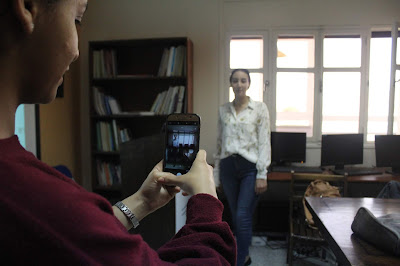Written by Ms. Hafida Mazoud
 |
| Group picture with Peace Corps Volunteer Ms. Cassandra |
We cannot believe how quickly time flies! It is already Week 8, and we
have one more extra session. The upcoming meeting with our all of our RISERs
will be at the Closing Ceremony. Before jumping on how this session went, let
us first give you a brief recap.
The fifth session that was conducted back on May 19th was about
photojournalism. We invited a Peace Corps Volunteer, Ms. Cassandra Broadwing,
to facilitate this session. The objective of this session was to enable the
RISERs to identify the components of a compelling image to articulate the
ethics of photojournalism and to pitch their own ideas for a photo essay to
promote social change and social justice in Agadir.
Ms. Cassandra started the session by projecting the photo of an Afghan
girl taken by Steve McCurry. She asked our participants if they recognized the
picture first and what they could describe by taking a closer look. After she
then told them about her story and projected a short video documenting the rest
of the story about this girl and how 17 years later the National Geographic
team found the girl and took the second picture of her.
 |
| The Egg Activity |
Between the two pictures, that girl had faced and experienced many
things, and her unrequested fame didn’t help her but instead made her life even
harder. This led our facilitator to start a discussion about whether what the
photographer leaves out of the image is just as important as what he or she
captures. She also addressed the strengths of using photography to tell stories
as well as its weaknesses.
This session was an opportunity for the participants to learn about the
elements of photography, what makes a photo compelling and how a photo can make
you feel something. Ms. Cassandra asked one of the participants to help her do
an activity where the participants shined a light on an egg with a drawn face
in order to use light to portray an evil face, a sad face, or a happy, angelic
face just by changing the light angles.
Photojournalism is photography, but the reverse is not necessarily true.
To illustrate the differences between these two concepts, they talked about
photojournalism and ethics, empathy, media bias, and how it is a journalist's
duty to remain emotionally aware and empathetic.
Before closing this session, we gave a handout to our participants that
helped them brainstorm the idea they want to tackle in their photo essay
assignment and explained the tools and the data they need in order to research
the idea.
 |
| RISERs taking shots of their partners |
Video Journalism was the theme of the following session. The session was
led by Ms. Katie Tyler and our intern Ms. Imane Arjdal who helped our RISERs
define what is videojournalism and its different forms. Later, they were
introduced to the different phases of videojournalism from pre-production,
production, and post-production.
Practicing videojournalism as an amateur or a professional was also
brought up during the discussion. This led to explaining what digital and
visual storytelling is, its ABCs and how you can exercise these principles
through video production. We also covered how video editing can help to refine
the final product to achieve a smooth, unbroken flow of the narrative.
In regard to the narrative, we talked about narration and the use of a
strong narrative voice. As an example, we played a video of Morgan Freeman and
studied how the use of his voice gives a different perspective for the story.
We are not contradicting with what we said above, but we always love to
challenge our RISERs’ creativity, and we asked them to produce a video with a
journalistic approach about any topic they want without spoken words. They
could use subtitles, infographics or background music to help deliver their
story.
 |
| Game time during the session |
Now we arrived to the eighth week which was the last taught session of
the RISE Citizen Journalism Program 2019. This session was about environmental
journalism, and its goal was to show that the environment is not a faraway
issue that only affect glaciers, but it contains crises that touch us every
day, and this is why having a journalistic coverage is a must!
We then distributed two different printed articles and asked the
participants to compare the different writing styles, such as whether the style
was descriptive, narrative, or both. One of the articles we chose for them was
about how climate change is creating a rise of child brides. They were blown
away by the connection and realized that if they analyze many environmental
issues, they would find a direct consequence of that issue in their lives or
the lives of others around them. We concluded this session by watching a video
that discusses the differences between facts and opinion as well as and what is
truth.
The participants requested many times to conduct a session where they
can learn about how to study abroad and find scholarships. Our RISE team could
not be happier to answer their request and provide them with the opportunity to
discuss and learn more about this topic for one more extra informative session
organized during the first week of Ramadan.
 |
| Group photo with Ms. Tasnim |

No comments:
Post a Comment